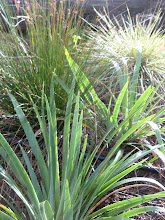I used to go several times a week on this same trail when I was attending Humboldt State University. I've been living nearby off and on for the last couple of years, but when I am staying in the area I go at least once a week. It's not the most impressive redwood forest, since it's a second-growth managed forest, but there are wonderful corners here and there where you can feel lost.
( I have been lost several times in this forest..this is how I originally found the trail.)
Katie is home for the summer and so is our mom's poodle, Annie.


 The Color
The ColorMay is a good time for a hike. I've been impatient, but the Clintonia andrewsiana are finally beginning to bloom. When the flowers dissappear, they'll be replaced by spectacular blue egg-shaped berries. I have Clintonia seedlings growing in a flat at Bayside, but it will be several years before they look like this.



The diversity of flower color in douglas iris is intriguing. My favorites are the pale blue ones, but they also come in deep red-purple, and intermediate shades.



Mimulus dentatus is one of those plants I discovered, propagated, and identified. There's now a nice patch growing in thre creek near the Bayside House. It's similar to M. guttatus the common yellow monkeyflower, but is more graceful and delicate. The leaves are thinner and softer with serrated edges, and the flowers are more trumpet shaped. It also blooms much earlier.
Rubus parviflorus is spineless with big soft maple-like leaves, large flowers, and edible berries. The Northcoast Journal published a nice article about this plant. (I think the berries are like a mild rasperry.)
 The Greenery
The GreeneryStreptopus amplexifolius var. americanus, the twisted stalk. It's form is very architectural.

Blechnum splicant, the common deer fern, is uncommonly cool.
 The spore producing leaves are more skeletal, and they'll turn dark and dry when they go into production
The spore producing leaves are more skeletal, and they'll turn dark and dry when they go into production



Fully back from it's winter rest, is the five-fingered fern, Adiantum pedatum.
 The black wiry stems and leaf ribs were, and perhaps are, the main source of black basketry material for the native peoples of the area.
The black wiry stems and leaf ribs were, and perhaps are, the main source of black basketry material for the native peoples of the area.

 The fresh growth of conifers stand out in the darkness. Here are the new needles of the coastal redwood, Sequoia sempervirens.
The fresh growth of conifers stand out in the darkness. Here are the new needles of the coastal redwood, Sequoia sempervirens.

Flowers of the piggyback plant, Tolmiea menzesii, common houseplant elsewhere, a native forest dweller locally. 



Blechnum splicant, the common deer fern, is uncommonly cool.
 The spore producing leaves are more skeletal, and they'll turn dark and dry when they go into production
The spore producing leaves are more skeletal, and they'll turn dark and dry when they go into production
while the vegetative leaves begin as lime zigzags and darken into a more subtle green.


Fully back from it's winter rest, is the five-fingered fern, Adiantum pedatum.
 The black wiry stems and leaf ribs were, and perhaps are, the main source of black basketry material for the native peoples of the area.
The black wiry stems and leaf ribs were, and perhaps are, the main source of black basketry material for the native peoples of the area.
 The fresh growth of conifers stand out in the darkness. Here are the new needles of the coastal redwood, Sequoia sempervirens.
The fresh growth of conifers stand out in the darkness. Here are the new needles of the coastal redwood, Sequoia sempervirens.
Flowers of the piggyback plant, Tolmiea menzesii, common houseplant elsewhere, a native forest dweller locally.
The bright suspended stars of Trientalis borealis.

Petasites frigidis next to sword fern, Polystichum munitum, and redwood sorrel, Oxalis oreganum.
Sunlight
Time to emerge from the shadows.


Same time next week okay?













3 comments:
That's a long article about a plant most people apparently believe there isn't much to say about. Nevin Smith is a fan of thimbleberry too.
The deer ferns are pretty nifty. I'm surprised I was in the redwoods for almost a week in May, and didn't take a photo of some fiddle heads.
Cheers,
MDV
Oregon
You still in Philly? Would like to read some similar pros of Fairmont Park:-). Good luck to you whatever your doing.
Post a Comment